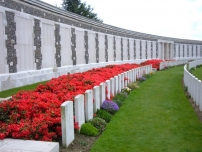| First Name: | Frederick | Last Name: | BENTLEY | |
|---|---|---|---|---|
| Date of Death: | 04/10/1917 | Lived/Born In: | Regent's Park | |
| Rank: | Private | Unit: | Royal West Surrey (Queens)3/4 | |
| Memorial Site: | Tyne Cot Memorial, Belgium | |||
Current Information:Age-42 Born-Worcester
Third Battle of Ypres This was a campaign fought between July and November 1917 and is often referred to as the Battle of Passchendaele, a village to the north-east of Ypres which was finally captured in November. It was an attempt by the British to break out of the Ypres salient and capture the higher ground to the south and the east from which the enemy had been able to dominate the salient. It began well but two important factors weighed against them. First was the weather. The summer of 1917 turned out to be one of the the wettest on record and soon the battlefield was reduced to a morass of mud which made progress very difficult, if not impossible in places. The second was the defensive arrangements of concrete blockhouses and machine gun posts providing inter-locking fire that the Germans had constructed and which were extremely difficult and costly to counter. For 4 months this epic struggle continued by the end of which the salient had been greatly expanded in size but the vital break out had not been achieved. The Battle of Broodseinde - 4th October, 1917 After the disappointing opening battles of the last day of July and the middle of August, when very little had been gained but at great cost in casualties, a new approach was adopted for the next offensives against the Gheluvelt plateau which began on 20th September with the Battle of the Menin Road, was continued on 26th September, when the Battle of Polygon Wood commenced, and was concluded on 4th October with the Battle of Broodseinde. The task was handed over to General Plumer, commander of the Second Army, a more cautious leader who, rather than try to drive as deep as possible into the German line, was an advocate of 'bite and hold' tactics with limited advances of no more than 1,500 yards, based on overwhelming firepower and exhaustive preparation. These new tactics, which were significantly aided by a period of warm, dry weather, worked well and September and early October saw a decisive phase of Third Ypres in which the British gained the upper hand. At the same time that Plumer’s Second Army were hammering away at the German defences on the Gheluvelt plateau, Fifth Army also attacked in the northern part of the Ypres salient and they too made gains. Both sides were planning an attack on 4th October and when the British bombardment began, it caught a number of German units out in the open preparing for their own attack. Zero hour was either 5.25am or 6am and at that time, Australian, New Zealand and British divisions moved into action behind a creeping artillery barrage. As at Menin Road Ridge and Polygon Wood, the British attack achieved its main objectives and then halted to dig in. The Germans lost heavily on 4th October and the battle was recorded as a “black day” in the official German history of the war. 3/4th Royal West Surrey (Queens) arrived in France in June 1917 and in July, after a period of trench instruction, joined 62 Brigade of 21st Division near Arras. They remained here until September when the 21st Division moved north to Ypres and the Battle of Passchendaele. The battalion’s first major engagement came on 4th October when 21st Division attacked out of Polygon Wood towards Reutel. At 6am, 3/4th Queens led 62 Brigade’s attack while on their right 9th Yorkshire Light Infantry did likewise on 64 Brigade’s front. The two battalions made their way across the Polygonbeek, a small stream surrounded by a morass of mud, in the face of fire from a number of concealed pill-boxes on the opposite bank. Despite a number casualties these pill-boxes were taken, an outstanding feat in the circumstances according to the Official History. Juniper Trench was taken and they then moved on to Judge Trench which was consolidated. At this stage the support battalions passed through on their way to the second objective and 3/4th Queens fell back to Jetty Wood, on the eastern side of Polygon Wood where they dug themselves in. This was just as well because by now the enemy artillery was at full throttle and continued in this vein up until 3/4th Queens were relieved from these positions during the night of 7th-8th October by which time the battalion had sustained well over 250 casualties. One of these was Frederick Bentley who was killed on 4th October. |
||||
| « Back to Search Results | ||||
| If you think any of the information shown here is incorrect, Click Here to submit your amends and comments | ||||




